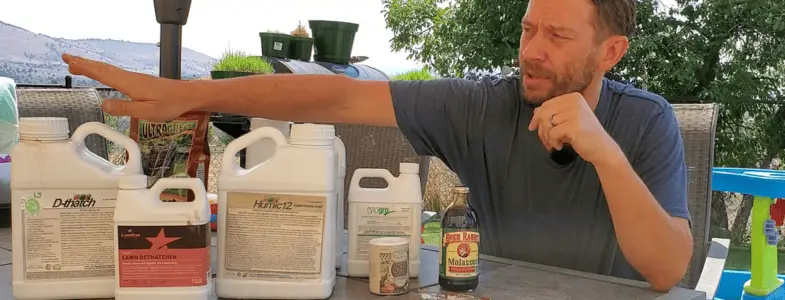A thick layer of thatch in a lawn setting is basically the same thing as a thin layer of organic material that hasn’t composted down and assimilated into the soil.
In a compost pile this would be a 3x3x3 pile of debris that is routinely turned so as to maintain the aerobic environment necessary for decomposition but in a lawn things are different. Instead of a pile we have thin layers that are spread very wide instead of a tall pile.
Thatch can still be broken down however by introducing adequate moisture, oxygen, and nitrogen to the layer during the warmest parts of the year, late Spring through early autumn.
To get your thatch layer to compost down or break down we need to apply a starter material in addition to the air and moisture. The base for this starter is molasses and yeast with a touch of organic nitrogen.
The yeast will activate at lower temps and will be particularly good at slowly breaking down woody or fibrous layers of thatch. It will also stimulate the activity of beneficial microorganisms and cause them to eat away at the molasses as a food source.
As microbial life in the soil increases, its ability to break down thatch intensifies. Worms and other small creatures shred material into little bits but the bacteria finishes the job off leaving you with rich soil that was sourced from undesirable material sitting above the soil in your lawn and below the leaf canopy.
To make your own liquid lawn dethatcher you’ll want to mix for every 1000 square feet of lawn space:
- a tablespoon of molasses
- a tablespoon of yeast
- and a gallon of aquarium water (or a cup of household ammonia mixed into a gallon of tap water)
In addition the inclusion of 2-3 ounces of humic acids will help with plant nutrient uptake, 1-ounce of cytogro or any other source of cytokinins will help with root development beneath the thatch layer, and soluble mycorrhizae will extend the reach of root systems through the colonization of beneficial fungi.
If you want to piecemeal this concoction together then I’ve provided affiliate links to many of the products I used below:
► Molasses – Just go buy this at your local grocery store.
► Yeast – You can buy this in small amounts at your local store or you can pick up a pound of it through this Amazon affiliate link.
► Low Dose Nitrogen Fert – You can use household ammonia from a local grocery store or use freshwater aquarium water like I did for some natural and well diluted nitrogen that is absolutely necessary for efficient thatch layer decomposition.
► N-Ext Humic12 – This is a brand I use that offers high quality humic/fulvic acids in a liquid suspension making mixing soluble powders an unnecessary task. You can get other brands on Amazon or a local garden supply store, but I buy my Humic12 from Yard Mastery. Here’s a direct affiliate link.
► Myco Bliss 1lb Organic Mycorrhizal Fungi – This is a powder that can be mixed and sprayed from the same tank. It works by colonizing your lawn soil with beneficial fungi that work with your plants root system to enhance their nutrient uptake and reach. You can find this stuff through this Amazon affiliate link.
► CytoGro – This is my product of choice for delivering a dedicated and potent source of cytokinins to my lawn. Cytokinins are found in sea kelp extracts and they stimulate plan systems to grow healthier and deeper root systems which are then used to increase plant health and stress resistance. This product is also on Yard Mastery. You can see it through this affiliate link.
► N-EXT D-Thatch via Yard Mastery
► Lawn Star Liquid Dethatcher via Amazon
I’ve actually documented me making and applying this DIY dethatcher solution to my lawn. I enjoyed making the solution and applying it and I think it’s worth doing yourself if you are hesitant buying anything yourself. Take a look at this video to see my experience with the DIY method.
If you want to learn more about thatch I have a full playlist of thatch Q&A over on Turf Mechanic Briefs here.
Or you can see any of the related thatch articles found on this website in the list below:
► The Best Liquid Thatch Removers Reviewed + How Thatch Digesters Work
► How To Remove Lawn Thatch: Best 5 Ways To Get Rid Of Thatch Compared
► Why Your Lawn is Spongy, Soft, or Squishy
► The Best Electric Dethatchers & Scarifiers For Lawns w/ Comparisons & Alternatives
► What Causes Thatch To Build Up & How To Stop It
► Should You Dethatch Your Lawn Every Spring?
► Is Old Dead Brown Grass or Thatch a Nitrogen Source for Compost?

